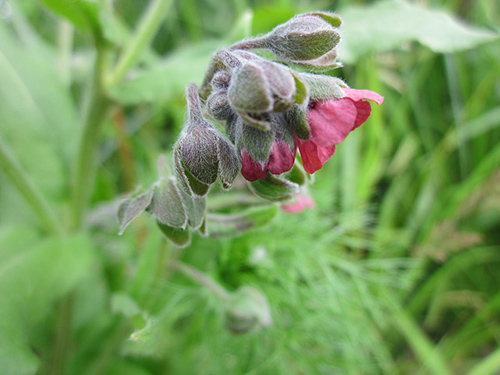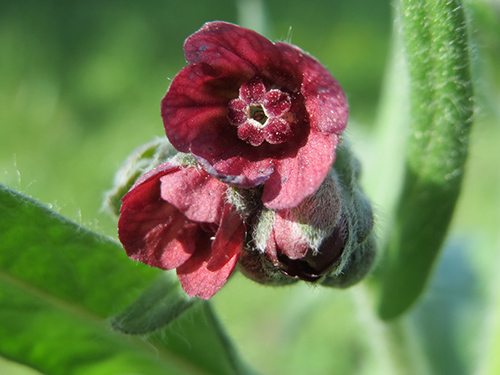Contents
The hounds tongue plant has been used from the 16th century onwards as part of some famous French pills (at that time) discovered by the renowned French surgeon Ambroise Pare (1510-1590). Beside hound’s tongue, these pills contained opium, henbane, saffron, incense, and myrrh. However, these pills are no longer used, and the herb is generally only applied externally.

Hounds Tongue Plant Scientific Facts
- Other names: Dog-burr, dog’s tongue, gypsy flower, sheeplice, woolmat, cynoglossum officinale.
- French: Language-de-Chien.
- Spanish: Cinoglosa.
- Environment: It spread all over Europe and was naturalized in warm regions of America, though seldom found. It grows on roadsides and unfarmed lands.
- Description: Vivacious plant of the Boraginaceae family, growing from 30 to 80cm high, with green-greyish large, soft, hairy leaves and wine-red flowers. The plant has a fetid odor.
- Parts of the plant used medicinally: The root when dried and the leaves when fresh.
Healing Properties and Indications

The root of the hound’s tongue plant contains alkaloids (cynoglossine), a toxic glycoside (consolidine), a bitter component (cynglossidine), mucin, allantoin, and tannin. Its leaves are especially rich in allantoin and tannin. Allantoin is an emollient and healing substance with several creams and pharmaceutical preparations.

Hounds tongue has astringent and soothing properties. In external application, it has emollient (calms the inflamed skin mucosa) properties and wound-healing properties due to its allantoin content.
This plant has been used as an infusion for antidiarrheic and pectoral purposes, but since it is harmful to the liver, its external use only is recommended. However, its main application is in external use as a cicatrizant for skin cracks, burns, torpid ulcerations, and complex healing wounds.
Hand baths with a decoction of the hound’s tongue soothe and hydrate the skin and hands and are very useful for dry skin due to cold or chemical products.

How to Use Hounds Tongue
- Decoction with a spoonful of ground root per cup of water. Drink one cup per day.
- Poultices with mashed leaves are applied to the affected skin for 30 minutes.
- Compresses with the plant’s fresh juice or a decoction of its root.
- Hand baths with a decoction of hound’s tongue prepared with 50g of leaves and root per liter of water, boiling for 5 minutes.
DISCLAIMER: All content on this website is presented solely for educational and informational objectives. It would be best to not rely on the information provided as a replacement for advice, diagnosis, or treatment from a qualified medical expert. If you are pregnant, nursing, or have any preexisting medical concerns, you should talk to your doctor before using any herbal or natural medicines.
REFERENCES
- George D. Pamplona-Roger, M.D. “Encyclopedia of Medicinal Plants.” George D. Pamplona-Roger, M.D. Encyclopedia of Medicinal Plants. Ed. Francesc X. Gelabert. vols. 2 San Fernando de Henares: Editorial Safeliz, 2000. 703. Print.
- Saeedi M, Ebrahimzadeh MA, Nabavi SF, et al. Antioxidant activity of Hound’s Tongue (Cynoglossum officinale L.). Pharm Biol. 2013 Mar;51(3):399-403. DOI: 10.3109/13880209.2012.729060.
- European Medicines Agency. Assessment report on Cynoglossum officinale L., radix. European Medicines Agency. EMA/HMPC/281328/2014.
- Tilford, G. L., & Wulff, M. L. (2009). Herbs for pets: The natural way to enhance your pet’s life. i5 Publishing.
- Skarnulis, L. (2000). Toxicity, Plant. In The Gale Encyclopedia of Science (3rd ed., Vol. 6, pp. 3431-3434). Gale.
- Tzakou, O., Pitarokili, D., & Chinou, I. (2003). Composition and antimicrobial activity of the essential oil of Cynoglossum creticum subsp. creticum. Planta medica, 69(10), 932-935.
- European Medicines Agency. Committee on Herbal Medicinal Products (HMPC). Community herbal monograph on Cynoglossum officinale L., radix. London: EMA. Doc. Ref. EMEA/HMPC/442188/2009.
